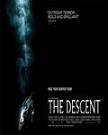|
|
||||
|
|
by Donald Levit  With a shorter, alternate ending for U.S. audiences after maybe scaring some of the rest of the globe, The Descent has received critics’ high marks for technical flair and a flunk for story. Its British writer-director Neil Marshall appeared at Lincoln Center's Film Comment Selects pre-release showing for a Q&A about his “Deliverance goes underground.” That mixed John Boorman rapids-running-gone-wrong thriller is not the only one written into The Descent. For more recent echoings, go to The Time Machine, Alien, First Blood, The Blair Witch Project, Pitch Black and Buffy the Vampire Slayer, for starters. The Descent is in many ways a sister film to Marshall's Dog Soldiers -- only featuring a half-dozen assorted women rather than six soldiers, and coming unglued instead of bonding. Marshall's current entry went through numerous drafts over two years, supposedly in a process of deepening characterization. Whatever the intent of such rewrites, The Descent's human protagonists are so stock shallow that only four (one of whom exits early) were afterwards identifiable by viewers, and still their names were fuzzy. Thus, the journey down and inwards, piercing Mother Earth but metaphorically “a descent into madness” and psyche, is not personally involving or convincing. The film's straightforward predictable storyline is no more or less remarkable than those of scores of other horror-sci fi movies but is well served by impressive photography, composition, and effects which are not overdone and not computer generated. On relatively limited funds, the realistic cavern system was actually six soundstage caves of spray resin foam at Pinewood Studios. Contributing to the effect was the decision not to use “gratuitous light sources,” so that things are obliquely half-lit by spelunker headlamps and thus require imaginative fill-in and, in a daring successful experiment, large areas of the screen are left in blackness. Horizontal, vertical, and diagonal lose meaning in the dark and can be, and are, interchanged. Six female friends go on annual extreme outdoor adventures, but, happily returning from white-water rafting, Sarah (Shauna Macdonald) loses her husband and daughter in a road accident. In a hospital where no one pays her any attention except for friend Beth (Alex Reid), she loses mental grip, as well, but, superficially recovered twelve months later, insists on accompanying the usual companions into a cave in the Following overheads of a “Rock chic” Bronco on winding roads, the other four are introduced to us in a mountain cabin, and the six set out in the early morning mist captained by Juno (Natalie Mendoza) after her jog intended to indicate the woman’s ego-drive. Relating back to Sarah’s tragedy, there are issues from some of the others’ embarrassed failure to have contacted her, but the girls joke, gripe and seem to get along famously enough. Juno’s protégée Holly (Nora-Jane Noone), a lightly punky “mentalist [who] jumps off high places,” and half-sisters professional climber Rebecca (Saskia Mulder) and medical student Sam (Myanna Buring) complete the package that passes a reeking maggoty deer carcass to begin their roped descent into what resembles a mouth into the piney mountainside. Along with where the convenient copper pipes in Sarah’s accident came from, do not ask how pushy Juno knew unerringly where to find this opening, for, disdaining touristy stuff in a guidebook cave, she unilaterally has switch-and-baited to an unknown, unmapped one. When the others find this out, and that the outside world will have no idea where or if to search for them, a boulder has already blocked the entrance tunnel behind. Plunging ahead for a hoped alternate exit, they find old metal objects like a piton and maybe a helmet, hunters’ paintings out of In the old familiar pattern, the women are singly picked off, one of them in a reflex-action mistake with a pointed “Love Each Day” pendant (some viewers saw, instead, a climber’s pick). And then there were two. (Released by Lionsgate Films and rated “R” for strong violence/gore and language.) |
||
|
© 2024 - ReelTalk Movie Reviews Website designed by Dot Pitch Studios, LLC |



